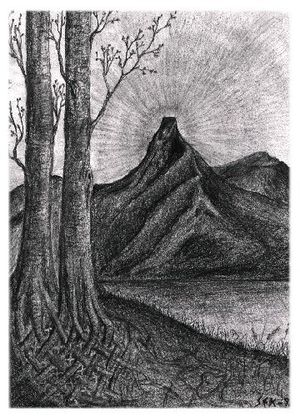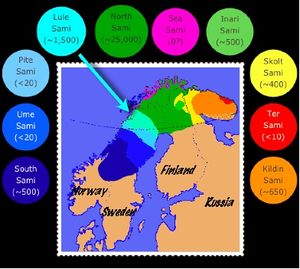Difference between revisions of "About Lule Sami"
m (Documenting Lule Saami moved to About Lule Sami: What now is called Documenting Lule Saami talks about Sami culture and the history of the language while the associated talk page talks about the documentation. So some change is necessary :)) |
|||
| Line 1: | Line 1: | ||
[[Image:ruohtsa.JPG|thumb|left|"Roots" © Svenn-Egil Knutsen]] | [[Image:ruohtsa.JPG|thumb|left|"Roots" © Svenn-Egil Knutsen]] | ||
| − | + | The Sami are an indigenous people living in Norway, Sweden, Finland and Russia. Their territory stretches from the Kola peninsula in northwestern Russia to Engerdal in southern Norway and Idre in southern Sweden. This area is called Sápmi in the Northern Saami language. Traditionally, the Sami have lived by reindeer herding, fishing, hunting and farming, but today, they have both traditional and modern jobs. There are many interesting sites about Sami and the Sami people that you can visit online: [[Lule Saami online]] | |
| − | + | ||
| − | + | ||
| − | + | ||
[[Image:boblekart.jpg|thumb|left|Here is a map of Scandinavia with the Sami areas in color. Modified by Bruce Morén]] | [[Image:boblekart.jpg|thumb|left|Here is a map of Scandinavia with the Sami areas in color. Modified by Bruce Morén]] | ||
| − | |||
| − | + | Sami has been spoken on the Scandinavian and Kola Peninsulas in Northwest Europe since prehistoric times. Recent genetic, archaeological and linguistic research suggests that the Sami people are descendants of the first inhabitants of the area after the glaciers of the last ice-age receded. | |
| − | Linguists currently recognize 9 living | + | Linguists currently recognize 9 living Sami languages. Lule Sami is the second largest of these. It is spoken by about 1,500 people. The traditional Lule Sami area runs from Luleå in Sweden on the Gulf of Bothnia to Nordland in Norway. This is shown on the following map. Note that the Sea Sami no longer have an independent language, but have adopted North Sami, Lule Sami or Norwegian. |
| − | + | Archaeological evidence shows that Sábme/Sápmi extended along most of the western coast of the Gulf of Bothnia and reached as far south as Hudiksvall. This area is called Sápmi in the Northern Sami language.The area is shown here, but not on most modern maps for political reasons. The Sami also lived farther east and south in Finland than is shown here. | |
| − | The | + | The Sami languages belong to the Uralic language family unrelated to most of the other languages in Western Europe. The closest relatives are Finnish and Estonian, yet the Sami separated from these more than 3,000 years ago. |
Although the Saami languages are classified as Finno-Ugric, their vocabularies are heavily influenced by contact with Slavic and Germanic neighbors. In addition, recent research suggests that they also contain remnants of the original Paleolithic languages of Scandinavia. | Although the Saami languages are classified as Finno-Ugric, their vocabularies are heavily influenced by contact with Slavic and Germanic neighbors. In addition, recent research suggests that they also contain remnants of the original Paleolithic languages of Scandinavia. | ||
Because of its long independent history and the relatively few number of speakers (i.e. less than 30,000 total), the Saami language family is arguable the most endangered language family in Europe (UNESCO Redbook of Endangered Languages). | Because of its long independent history and the relatively few number of speakers (i.e. less than 30,000 total), the Saami language family is arguable the most endangered language family in Europe (UNESCO Redbook of Endangered Languages). | ||
Revision as of 15:59, 12 November 2008
The Sami are an indigenous people living in Norway, Sweden, Finland and Russia. Their territory stretches from the Kola peninsula in northwestern Russia to Engerdal in southern Norway and Idre in southern Sweden. This area is called Sápmi in the Northern Saami language. Traditionally, the Sami have lived by reindeer herding, fishing, hunting and farming, but today, they have both traditional and modern jobs. There are many interesting sites about Sami and the Sami people that you can visit online: Lule Saami online
Sami has been spoken on the Scandinavian and Kola Peninsulas in Northwest Europe since prehistoric times. Recent genetic, archaeological and linguistic research suggests that the Sami people are descendants of the first inhabitants of the area after the glaciers of the last ice-age receded.
Linguists currently recognize 9 living Sami languages. Lule Sami is the second largest of these. It is spoken by about 1,500 people. The traditional Lule Sami area runs from Luleå in Sweden on the Gulf of Bothnia to Nordland in Norway. This is shown on the following map. Note that the Sea Sami no longer have an independent language, but have adopted North Sami, Lule Sami or Norwegian.
Archaeological evidence shows that Sábme/Sápmi extended along most of the western coast of the Gulf of Bothnia and reached as far south as Hudiksvall. This area is called Sápmi in the Northern Sami language.The area is shown here, but not on most modern maps for political reasons. The Sami also lived farther east and south in Finland than is shown here.
The Sami languages belong to the Uralic language family unrelated to most of the other languages in Western Europe. The closest relatives are Finnish and Estonian, yet the Sami separated from these more than 3,000 years ago.
Although the Saami languages are classified as Finno-Ugric, their vocabularies are heavily influenced by contact with Slavic and Germanic neighbors. In addition, recent research suggests that they also contain remnants of the original Paleolithic languages of Scandinavia.
Because of its long independent history and the relatively few number of speakers (i.e. less than 30,000 total), the Saami language family is arguable the most endangered language family in Europe (UNESCO Redbook of Endangered Languages).

